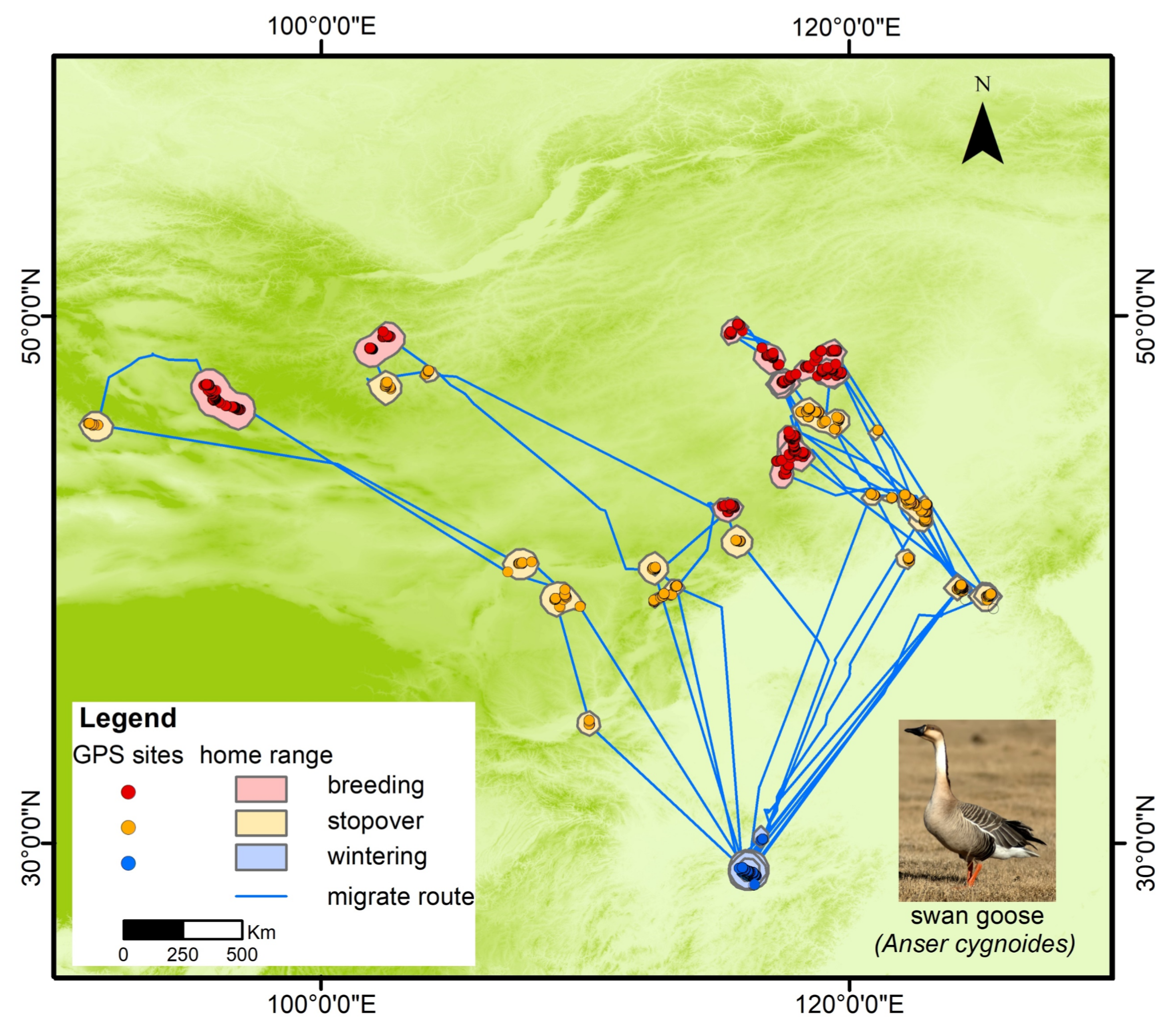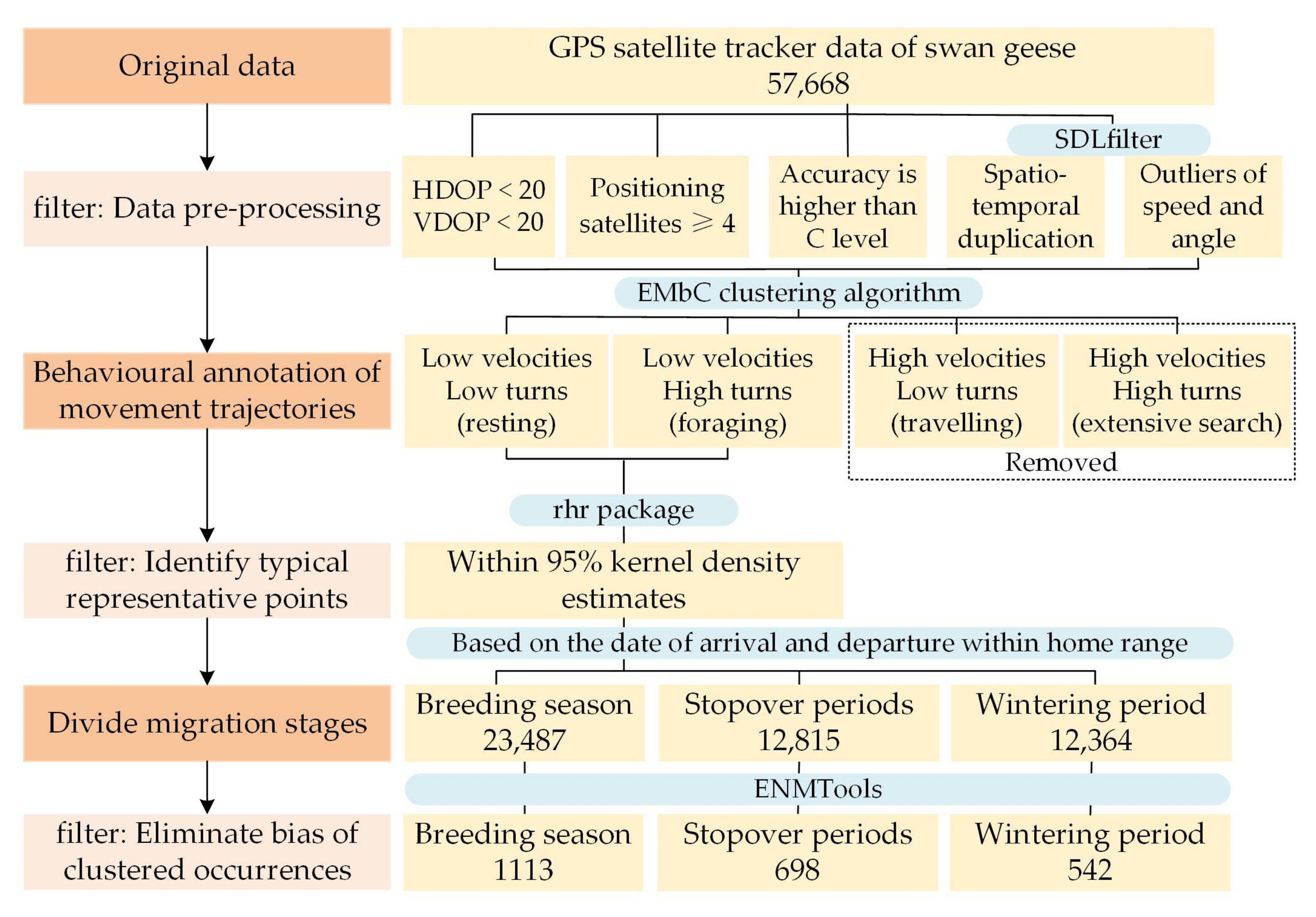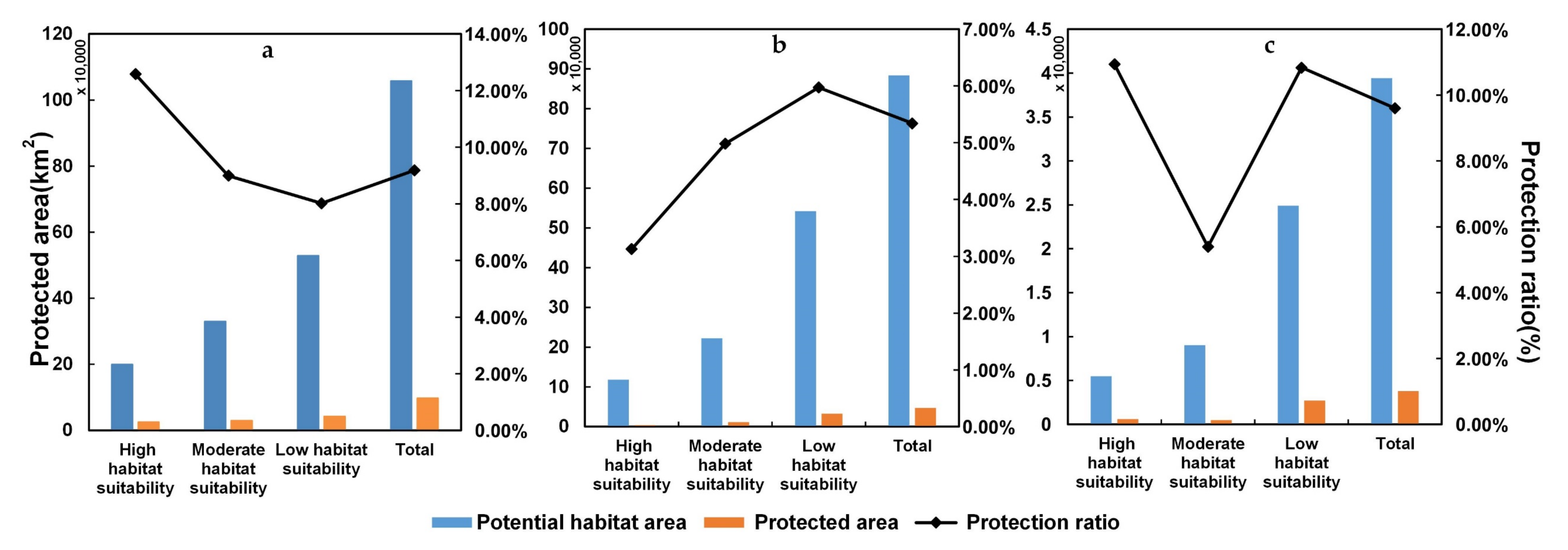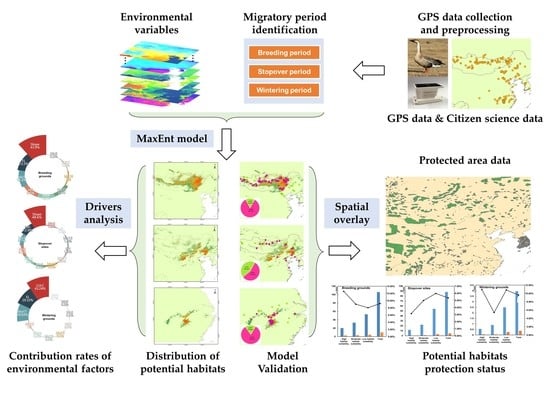Potential Habitats and Their Conservation Status for Swan Geese (Anser cygnoides) along the East Asian Flyway
Abstract
:1. Introduction
2. Materials and Methods
2.1. Study Area
2.2. GPS Data Collection and Preprocessing
2.3. Environmental Variables
2.4. Model Simulation
2.4.1. Parameter Setting
2.4.2. Model Validation
2.5. Protection Status Analysis
3. Results
3.1. Validation of Potential Habitats for Swan Geese
3.2. Distribution of Potential Habitats for Swan Geese
3.3. Main Environmental Factors
3.4. Analysis of Habitat Protection Status
4. Discussion
4.1. GPS Data Used for Habitat Simulation
4.2. Significant Factors Affecting Habitat Suitability
4.3. The Challenge of Protecting Swan Geese
5. Conclusions
Supplementary Materials
Author Contributions
Funding
Data Availability Statement
Acknowledgments
Conflicts of Interest
References
- Cody, M.L. Habitat Selection in Birds; Academic Press: Cambridge, MA, USA, 1985. [Google Scholar]
- Weller, M.W. Wetland Birds: Habitat Resources and Conservation Implications; Cambridge University Press: Cambridge, UK, 1999. [Google Scholar]
- Hildén, O. Habitat selection in birds: A review. Ann. Zool. Fenn. 1965, 2, 53–75. [Google Scholar]
- Fischer, J.; Lindenmayer, D.B. Landscape modification and habitat fragmentation: A synthesis. Global Ecol. Biogeogr. 2007, 16, 265–280. [Google Scholar] [CrossRef]
- Kirby, J.S.; Stattersfield, A.J.; Butchart, S.; Evans, M.I.; Newton, I. Key conservation issues for migratory land- and waterbird species on the world’s major flyways. Bird Conserv. Int. 2008, 18, S49–S73. [Google Scholar] [CrossRef] [Green Version]
- Haig, S.M.; Murphy, S.P.; Matthews, J.H.; Arismendi, I.; Safeeq, M. Climate-Altered Wetlands Challenge Waterbird Use and Migratory Connectivity in Arid Landscapes. Sci. Rep. 2019, 9, 4666. [Google Scholar] [CrossRef] [PubMed] [Green Version]
- Roshier, D.A.; Robertson, A.I.; Kingsford, R.T. Responses of waterbirds to flooding in an arid region of Australia and implications for conservation. Biol. Conserv. 2002, 106, 399–411. [Google Scholar] [CrossRef]
- Brandis, K.J.; Bino, G.; Spencer, J.A.; Ramp, D.; Kingsford, R.T. Decline in colonial waterbird breeding highlights loss of Ramsar wetland function. Biol. Conserv. 2018, 225, 22–30. [Google Scholar] [CrossRef]
- An, A.; Zhang, Y.; Cao, L.; Jia, Q.; Wang, X. A potential distribution map of wintering Swan Goose (Anser cygnoides) in the middle and lower Yangtze River floodplain, China. Avian Res. 2018, 9, 43. [Google Scholar] [CrossRef] [Green Version]
- Duan, H.; Yu, X.; Xia, S.; Zhang, G. Waterbird habitat loss fringing the Yellow and Bohai seas along the East Asian—Australasian migratory flyway. Land Degrad. Dev. 2021. accepted. [Google Scholar] [CrossRef]
- Wang, Y.; Gong, M.; Zou, C.; Zhou, T.; Wen, W.; Liu, G.; Li, H.; Tao, W. Habitat selection by Siberian Cranes at their core stopover area during migration in Northeast China. Glob. Ecol. Conserv. 2022, 33, e1993. [Google Scholar] [CrossRef]
- Xu, Y.; Si, Y.; Wang, Y.; Zhang, Y.; Prins, H.H.T.; Cao, L.; de Boer, W.F. Loss of functional connectivity in migration networks induces population decline in migratory birds. Ecol. Appl. 2019, 29, e1960. [Google Scholar] [CrossRef] [Green Version]
- Wilmers, C.C.; Nickel, B.; Bryce, C.M.; Smith, J.A.; Wheat, R.E.; Yovovich, V. The golden age of bio-logging: How animal-borne sensors are advancing the frontiers of ecology. Ecology 2015, 96, 1741–1753. [Google Scholar] [CrossRef] [PubMed]
- Xin, W.; Lei, C.; Fox, A.D.; Fuller, R.; Ran, N. Stochastic simulations reveal few green wave surfing populations among spring migrating herbivorous waterfowl. Nat. Commun. 2019, 10, 2187. [Google Scholar]
- Monti, F.; Grémillet, D.; Sforzi, A.; Sammuri, G.; Dominici, J.M.; Triay Bagur, R.; Muñoz Navarro, A.; Fusani, L.; Duriez, O. Migration and wintering strategies in vulnerable Mediterranean Osprey populations. IBIS 2018, 160, 554–567. [Google Scholar] [CrossRef]
- Gao, B.; Gong, P.; Zhang, W.; Yang, J.; Si, Y. Multiscale effects of habitat and surrounding matrices on waterbird diversity in the Yangtze River Floodplain. Landsc. Ecol. 2021, 36, 179–190. [Google Scholar] [CrossRef]
- Xu, Y.; Si, Y.; Yin, S.; Zhang, W.; Grishchenko, M.; Prins, H.H.; Gong, P.; de Boer, W.F. Species-dependent effects of habitat degradation in relation to seasonal distribution of migratory waterfowl in the East Asian-Australasian Flyway. Landsc. Ecol. 2019, 34, 243–257. [Google Scholar] [CrossRef] [Green Version]
- Duan, H.; Xia, S.; Yu, X.; Liu, Y.; Teng, J.; Dou, Y. Using citizen science data to inform the relative sensitivity of waterbirds to natural versus human-dominated landscapes in China. Ecol. Evol. 2020, 10, 7233–7241. [Google Scholar] [CrossRef]
- John, R.; Chen, J.; Kim, Y.; Ou-Yang, Z.T.; Xiao, J.; Park, H.; Shao, C.; Zhang, Y.; Amarjargal, A.; Batkhshig, O. Differentiating anthropogenic modification and precipitation-driven change on vegetation productivity on the Mongolian Plateau. Landsc. Ecol. 2016, 31, 547–566. [Google Scholar] [CrossRef]
- Ganbold, O.; Munkhbayar, M.; Paik, I.; Bing, G.; Jargalsaikhan, A.; Purevee, E.; Peak, W.K. Globally threatened birds in Mongolia: A review. J. Asia-Pac. Biodivers. 2017, 10, 435–440. [Google Scholar] [CrossRef]
- Batbayar, N.; Takekawa, J. Migration strategies of Swan Geese Anser cygnoides from northeast Mongolia. Wildfowl 2011, 61, 90–109. [Google Scholar]
- Yu, H.; Wang, X.; Cao, L.; Zhang, L.; Jia, Q.; Lee, H.; Xu, Z.; Liu, G.; Xu, W.; Hu, B.; et al. Are declining populations of wild geese in China ‘prisoners’ of their natural habitats? Curr. Biol. 2017, 27, R376–R377. [Google Scholar] [CrossRef]
- Zhao, Q.; Wang, X.; Cao, L.; Fox, A.D. Why Chinese wintering geese hesitate to exploit farmland. IBIS 2018, 160, 703–705. [Google Scholar] [CrossRef] [Green Version]
- Lei, C.; Yong, Z.; Barter, M.; Gang, L. Anatidae in eastern China during the non-breeding season: Geographical distributions and protection status. Biol. Conserv. 2010, 143, 650–659. [Google Scholar]
- Zhang, Y.; Cao, L.; Barter, M.; Fox, A.D.; Zhao, M.; Meng, F.; Shi, H.; Jiang, Y.; Zhu, W. Changing distribution and abundance of Swan GooseAnser cygnoides in the Yangtze River floodplain: The likely loss of a very important wintering site. Bird Conserv. Int. 2011, 21, 36–48. [Google Scholar] [CrossRef] [Green Version]
- International Union for Conservation of Nature. Anser cygnoid. In The IUCN Red List of Threatened Species 2016: e.T22679869A92832782; International Union for Conservation of Nature: Gland, Switzerland, 2016; Volume 2021. [Google Scholar]
- Wu, Y.; Yang, Y.; Cao, L.; Yin, H.; Xu, M.; Wang, Z.; Liu, Y.; Wang, X.; Deng, Y. Habitat environments impacted the gut microbiome of long-distance migratory swan geese but central species conserved. Sci. Rep. 2018, 8, 13314. [Google Scholar] [CrossRef]
- Wu, H.; Dai, J.; Sun, S.; Du, C.; Long, Y.; Chen, H.; Yu, G.; Ye, S.; Chen, J. Responses of habitat suitability for migratory birds to increased water level during middle of dry season in the two largest freshwater lake wetlands of China. Ecol. Indic. 2021, 121, 107065. [Google Scholar] [CrossRef]
- JIa, Q.; Koyama, K.; Choi, C.; Kim, H.; Cao, L.; Gao, D.; Liu, G.; Fox, A.D. Population estimates and geographical distributions of swans and geese in East Asia based on counts during the non-breeding season. Bird Conserv. Int. 2016, 26, 397–417. [Google Scholar] [CrossRef]
- Nyambayar, B.; Tseveenmyadag, N. (Eds.) Directory of Important Bird Areas in Mongolia: Key Sites for Conservation; Wildlife Science and Conservation Center, Institute of Biology and BirdLife International: Ulaanbaatar, Mongolia, 2009. [Google Scholar]
- Teng, J.; Yu, X.; Xia, S.; Liu, Y. Suitable Habitat Dynamics of Wintering Geese in a Large Floodplain Wetland: Insights from Flood Duration. Remote Sens. 2022, 14, 952. [Google Scholar] [CrossRef]
- Kenward, R.E. A Manual for Wildlife Radio Tagging; Academic Press: Cambridge, MA, USA, 2000. [Google Scholar]
- Shimada, T.; Jones, R.; Limpus, C.; Hamann, M. Improving data retention and home range estimates by data-driven screening. Mar. Ecol. Prog. Ser. 2012, 457, 171–180. [Google Scholar] [CrossRef] [Green Version]
- Shimada, T.; Limpus, C.; Jones, R.; Hazel, J.; Groom, R.; Hamann, M. Sea turtles return home after intentional displacement from coastal foraging areas. Mar. Biol. 2016, 163, 8. [Google Scholar] [CrossRef]
- Garriga, J.; Palmer, J.R.B.; Oltra, A.; Bartumeus, F. Expectation-Maximization Binary Clustering for Behavioural Annotation. PLoS ONE 2016, 11, e151984. [Google Scholar] [CrossRef] [Green Version]
- Lamb, J.S.; Paton, P.W.; Osenkowski, J.E.; Badzinski, S.S.; Berlin, A.M.; Bowman, T.; Dwyer, C.; Fara, L.J.; Gilliland, S.G.; Kenow, K. Assessing year-round habitat use by migratory sea ducks in a multi-species context reveals seasonal variation in habitat selection and partitioning. Ecography 2020, 43, 1842–1858. [Google Scholar] [CrossRef]
- Signer, J.; Balkenhol, N. Reproducible home ranges (rhr): A new, user-friendly R package for analyses of wildlife telemetry data. Wildl. Soc. Bull. 2015, 39, 358–363. [Google Scholar] [CrossRef]
- Hernandez, P.A.; Graham, C.H.; Master, L.L.; Albert, D.L. The effect of sample size and species characteristics on performance of different species distribution modeling methods. Ecography 2006, 29, 773–785. [Google Scholar] [CrossRef]
- Luo, Z.; Jiang, Z.; Tang, S. Impacts of climate change on distributions and diversity of ungulates on the Tibetan Plateau. Ecol. Appl. 2015, 25, 24–38. [Google Scholar] [CrossRef] [PubMed]
- Fick, S.E.; Hijmans, R.J. WorldClim 2: New 1km spatial resolution climate surfaces for global land areas. Int. J. Climatol. 2017, 37, 4302–4315. [Google Scholar] [CrossRef]
- Jun, C.; Ban, Y.; Li, S. Open access to Earth land-cover map. Nature 2014, 514, 434. [Google Scholar] [CrossRef] [PubMed] [Green Version]
- Danielson, J.J.; Gesch, D.B. Global Multi-Resolution Terrain Elevation Data 2010 (GMTED2010); US Department of the Interior, US Geological Survey: Washington, DC, USA, 2011.
- Venter, O.; Sanderson, E.W.; Magrach, A.; Allan, J.R.; Beher, J.; Jones, K.R.; Possingham, H.P.; Laurance, W.F.; Wood, P.; Fekete, B.M.; et al. Global terrestrial Human Footprint maps for 1993 and 2009. Sci. Data 2016, 3, 160067. [Google Scholar] [CrossRef] [Green Version]
- Ma, B.; Sun, J. Predicting the distribution of Stipa purpurea across the Tibetan Plateau via the MaxEnt model. BMC Ecol. 2018, 18, 10. [Google Scholar] [CrossRef] [Green Version]
- Phillips, S.J.; Anderson, R.P.; Schapire, R.E. Maximum entropy modeling of species geographic distributions. Ecol. Model. 2006, 190, 231–259. [Google Scholar] [CrossRef] [Green Version]
- Bean, W.T.; Stafford, R.; Brashares, J.S. The effects of small sample size and sample bias on threshold selection and accuracy assessment of species distribution models. Ecography 2012, 35, 250–258. [Google Scholar] [CrossRef]
- Liu, C.; Berry, P.M.; Dawson, T.P.; Pearson, R.G. Selecting thresholds of occurrence in the prediction of species distributions. Ecography 2005, 28, 385–393. [Google Scholar] [CrossRef]
- Luan, X.; Yi, Q.; Li, D.; Liu, S.; Wang, X.; Wu, B.; Zhu, C. Habitat evaluation of wild Amur tiger (Panthera tigris altaica) and conservation priority setting in north-eastern China. J. Environ. Manag. 2011, 92, 31–42. [Google Scholar]
- Fielding, A.H.; Bell, J.F. A review of methods for the assessment of prediction errors in conservation presence/absence models. Environ. Conserv. 1997, 24, 38–49. [Google Scholar] [CrossRef]
- Palm, E.C.; Newman, S.H.; Prosser, D.J.; Xiao, X.; Ze, L.; Batbayar, N.; Balachandran, S.; Takekawa, J.Y. Mapping migratory flyways in Asia using dynamic Brownian bridge movement models. Mov. Ecol. 2015, 3, 3. [Google Scholar] [CrossRef] [Green Version]
- Li, X.; Si, Y.; Ji, L.; Gong, P. Dynamic response of East Asian Greater White-fronted Geese to changes of environment during migration: Use of multi-temporal species distribution model. Ecol. Model. 2017, 360, 70–79. [Google Scholar] [CrossRef]
- Fox, A.D.; Lei, C.; Barter, M.; Rees, E.; Hearn, R.D.; Hao, P.C.; Xin, W.; Yong, Z.; Tao, D.S.; Fang, S.X. The functional use of East Dongting Lake, China, by wintering geese. Wildfowl 2008, 58, 3–19. [Google Scholar]
- VonBank, J.A.; Weegman, M.D.; Link, P.T.; Cunningham, S.A.; Kraai, K.J.; Collins, D.P.; Ballard, B.M. Winter fidelity, movements, and energy expenditure of Midcontinent Greater White-fronted Geese. Mov. Ecol. 2021, 9, 2. [Google Scholar] [CrossRef]
- Zhu, Q.; Damba, I.; Zhao, Q.; Yi, K.; Batbayar, N.; Natsagdorj, T.; Davaasuren, B.; Wang, X.; Rozenfeld, S.; Moriguchi, S.; et al. Lack of conspicuous sex-biased dispersal patterns at different spatial scales in an Asian endemic goose species breeding in unpredictable steppe wetlands. Ecol. Evol. 2020, 10, 7006–7020. [Google Scholar] [CrossRef]
- Dickey, M.; Gauthier, G.; Cadieux, M. Climatic effects on the breeding phenology and reproductive success of an arctic-nesting goose species. Glob. Chang. Biol. 2008, 14, 1973–1985. [Google Scholar] [CrossRef]
- Zhou, Q.; Zhao, X.; Wu, D.; Tang, R.; Du, X.; Wang, H.; Zhao, J.; Xu, P.; Peng, Y. Impact of Urbanization and Climate on Vegetation Coverage in the Beijing-Tianjin-Hebei Region of China. Remote Sens. 2019, 11, 2452. [Google Scholar] [CrossRef] [Green Version]
- Gong, P.; Niu, Z.; Cheng, X.; Zhao, K.; Zhou, D.; Guo, J.; Liang, L.; Wang, X.; Li, D.; Huang, H.; et al. China’s wetland change (1990–2000) determined by remote sensing. Sci. China Earth Sci. 2010, 53, 1036–1042. [Google Scholar] [CrossRef]
- Teng, J.; Xia, S.; Liu, Y.; Yu, X.; Duan, H.; Xiao, H.; Zhao, C. Assessing habitat suitability for wintering geese by using Normalized Difference Water Index (NDWI) in a large floodplain wetland, China. Ecol. Indic. 2021, 122, 107260. [Google Scholar] [CrossRef]
- Zhang, P.; Zou, Y.; Xie, Y.; Zhang, S.; Chen, X.; Li, F.; Deng, Z.; Zhang, H.; Tu, W. Hydrology-driven responses of herbivorous geese in relation to changes in food quantity and quality. Ecol. Evol. 2020, 10, 5281–5292. [Google Scholar] [CrossRef] [PubMed] [Green Version]
- Yu, Y. Ornithological survey in Dornod province, eastern Mongolia. BirdingASIA 2015, 24, 54–63. [Google Scholar]
- Hilker, T.; Natsagdorj, E.; Waring, R.H.; Lyapustin, A.; Wang, Y. Satellite observed widespread decline in Mongolian grasslands largely due to overgrazing. Glob. Chang. Biol. 2014, 20, 418–428. [Google Scholar] [CrossRef] [PubMed] [Green Version]
- Damba, I.; Fang, L.; Yi, K.; Zhang, J.; Batbayar, N.; You, J.; Moon, O.K.; Jin, S.D.; Liu, B.F.; Liu, G.; et al. Flyway structure, breeding, migration and wintering distributions of the globally threatened Swan Goose Anser cygnoides in East Asia. Wildfowl 2020, 97–123. Available online: https://wildfowl.wwt.org.uk/index.php/wildfowl/article/view/2739 (accessed on 29 January 2022).
- Zou, Y.; Tang, Y.; Xie, Y.; Zhao, Q.; Zhang, H. Response of herbivorous geese to wintering habitat changes: Conservation insights from long-term population monitoring in the East Dongting Lake, China. Reg. Environ. Chang. 2017, 17, 879–888. [Google Scholar] [CrossRef]
- Tian, Y.; Wang, Z.; Mao, D.; Li, L.; Liu, M.; Jia, M.; Man, W.; Lu, C. Remote Observation in Habitat Suitability Changes for Waterbirds in the West Songnen Plain, China. Sustainability 2019, 11, 1552. [Google Scholar] [CrossRef] [Green Version]
- Si, Y.; Xu, Y.; Xu, F.; Li, X.; Zhang, W.; Wielstra, B.; Wei, J.; Liu, G.; Luo, H.; Takekawa, J. Spring migration patterns, habitat use, and stopover site protection status for two declining waterfowl species wintering in China as revealed by satellite tracking. Ecol. Evol. 2018, 8, 6280–6289. [Google Scholar] [CrossRef]
- Yang, H.; Ma, M.; Thompson, J.R.; Flower, R.J. Protect coastal wetlands in China to save endangered migratory birds. Proc. Natl. Acad. Sci. USA 2017, 114, E5491–E5492. [Google Scholar] [CrossRef] [Green Version]
- Chen, H.; Zhang, W.; Gao, H.; Nie, N. Climate Change and Anthropogenic Impacts on Wetland and Agriculture in the Songnen and Sanjiang Plain, Northeast China. Remote Sens. 2018, 10, 356. [Google Scholar] [CrossRef] [Green Version]






| Migration Stages | Processed GPS Sites | Environmental Factors |
|---|---|---|
| Breeding period | 1113 | bio1, bio2, bio3, bio4, bio15, bio19, EVI-Aug., EL, Slope, LULC, HFI |
| Stopover period | 698 | bio1, bio2, bio3, bio4, bio13, bio15, bio17, EVI-Apr. and Oct., EL, Slope, LULC, HFI |
| Wintering period | 542 | bio2, bio3, bio4, bio9, bio10, bio13, bio15, bio17, EVI-Jan., EL, Slope, LULC, HFI |
| Potential Habitats | Low Habitat Suitability Areas | Moderate Habitat Suitability Areas | High Habitat Suitability Areas | Total Areas |
|---|---|---|---|---|
| Breeding grounds | 528,853 (49.97%) | 330,047 (31.19%) | 199,423 (18.84%) | 1,058,323 |
| Stopover sites | 542,478 (61.39%) | 222,763 (25.21%) | 118,366 (13.40%) | 883,607 |
| Wintering grounds | 24,900 (63.16%) | 9031 (22.91%) | 5493 (13.93%) | 39,424 |
| Total | 1,096,231 (55.33%) | 561,841 (28.36%) | 323,282 (16.32%) | 1,981,354 |
Publisher’s Note: MDPI stays neutral with regard to jurisdictional claims in published maps and institutional affiliations. |
© 2022 by the authors. Licensee MDPI, Basel, Switzerland. This article is an open access article distributed under the terms and conditions of the Creative Commons Attribution (CC BY) license (https://creativecommons.org/licenses/by/4.0/).
Share and Cite
Wang, C.; Yu, X.; Xia, S.; Liu, Y.; Huang, J.; Zhao, W. Potential Habitats and Their Conservation Status for Swan Geese (Anser cygnoides) along the East Asian Flyway. Remote Sens. 2022, 14, 1899. https://doi.org/10.3390/rs14081899
Wang C, Yu X, Xia S, Liu Y, Huang J, Zhao W. Potential Habitats and Their Conservation Status for Swan Geese (Anser cygnoides) along the East Asian Flyway. Remote Sensing. 2022; 14(8):1899. https://doi.org/10.3390/rs14081899
Chicago/Turabian StyleWang, Chunxiao, Xiubo Yu, Shaoxia Xia, Yu Liu, Junlong Huang, and Wei Zhao. 2022. "Potential Habitats and Their Conservation Status for Swan Geese (Anser cygnoides) along the East Asian Flyway" Remote Sensing 14, no. 8: 1899. https://doi.org/10.3390/rs14081899
APA StyleWang, C., Yu, X., Xia, S., Liu, Y., Huang, J., & Zhao, W. (2022). Potential Habitats and Their Conservation Status for Swan Geese (Anser cygnoides) along the East Asian Flyway. Remote Sensing, 14(8), 1899. https://doi.org/10.3390/rs14081899







